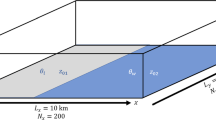Abstract
We discuss the structure and evolution of a cloud-free atmospheric boundary layer (ABL) during daytime over land, starting from a shallow ABL at sunrise and developing into a deep ABL with strong convection in the afternoon. The structure of the turbulence in the lower half of a convective ABL capped by an inversion is reasonably well understood. Less is known about the details of the turbulence in higher regions affected by entrainment, because of the difficulty in taking turbulence measurements there. For the evolution in time of the height of the ABL and its mean potential temperature mixed-layer models have been developed that give satisfactory agreement with observations. It has been shown that for many practical applications accurate knowledge of forcing functions and boundary conditions is more important than a refinement of the entrainment hypothesis. Observations show that the assumption of well-mixedness of first-order moments of conservative variables is not valid for all quantities. A simple similarity relation for the inclusion of the effect of entrainment on the shape of the vertical profiles is given.
Similar content being viewed by others
References
André, J.C., Lacarrère, P., and L.J. Mahrt, 1979: “Sur la distribution verticale de l'humidité dans la couche limite convective”. J. Rech. Atmos., 13, 135–146.
Caughey, S.J., 1982: “Observed characteristics of the atmospheric boundary layer”. In: Atmospheric Turbulence and Air Pollution Modelling. Eds. F.T.M. Nieuwstadt and H. van Dop. Reidel Publ., Holland, pp. 107–158.
Deardorff, J.W., 1974: “Three-dimensional numerical study of the height and mean structure of a heated planetary boundary layer”. Boundary-Layer Meteor., 7, 199–226.
Deardorff, J.W., 1980: “Stratocumulus-capped Mixed Layer derived from a three-dimensional model”. Boundary-Layer Meteor., 18, 495–527.
Deardorff, J.W., 1983: “A multi-limit mixed-layer entrainment formulation”. J. Phys. Oceanogr., 13, 988–1002.
Deardorff, J.W., Willis, G.E., and B.H. Stockton, 1980: “Laboratory studies of the entrainment zone of a convectively mixed layer”. J. Fluid Mech., 100, 41–46.
Deardorff, J.W., and G.E. Willis, 1982: “Ground-level concentrations due to fumigation into an entraining mixed layer”. Atmos. Env., 16, 1159–1170.
Driedonks, A.G.M., 1982a: “Sensitivity analysis of the equations for a convective mixed layer”. Boundary-Layer Meteor., 22, 475–480.
Driedonks, A.G.M., 1982b: “Models and observations of the growth of the atmospheric boundary layer”. Boundary-Layer Meteor., 23, 283–306.
Holtslag, A.A.M. and A.P. van Ulden, 1983: “A simple scheme for daytime estimates of the surface fluxes from routine weather data”. J. Clim. and Appl. Meteor., 22, 517–529.
Lamb, R.G., 1982: “Diffusion in the Convective Boundary Layer”. In: Atmospheric Turbulence and Air Pollution Modelling. Eds. F.T.M. Nieuwstadt and H. van Dop. Reidel Publ., Holland, pp. 159–230.
Mahrt, L.J. and J.C. André, 1983: “On the stratification of turbulent mixed layers”. J. Geophys. Research, 88, 2662–2666.
Manins, P.C., 1982: “The daytime planetary boundary layer: a new interpretation of Wangara data”. Quart. J. Roy. Met. Soc., 180, 689–705.
Panofsky, H.A., Tennekes, H., Lenschow, D.H., and J.C. Wyngaard, 1977: “The characteristics of turbulent velocity components in the surface layer under convective conditions”. Boundary-Layer Meteor., 11, 355–361.
Rayment, R., and C.J. Readings, 1974: “A case study of the structure and energetics of an inversion”. Quart. J. Roy. Met. Soc., 100, 221–233.
Reiff, J., Blaauboer, D., de Bruin, H.A.R., van Ulden, A.P., and G. Cats, 1983: “An air mass transformation model for short-range weather forecasting”. Mon. Wea. Rev., in press.
Scranton, D.R., and W.R. Lindber, 1983: “An experimental study of entraining, stress-driven, stratified flow in an annulus”. Physics of Fluids, 26, 1198–1205.
Tennekes, H. and A.G.M. Driedonks, 1981: “Basic entrainment equations for the atmospheric boundary layer”. Boundary-Layer Meteor., 20, 515–531.
Wyngaard, J.C., Coté, O.R., and Y. Izumi, 1971: “Local free convection similarity and the budgets of shear stress and heat flux”, J. Atmos. Sci., 28, 1171–1182.
Wyngaard, J.C., and M.A. LeMone, 1980: “Behavior of the refractive index structure parameter in the entraining convective boundary layer”. J. Atmos. Sci., 37, 1573–1585.
Wyngaard, J.C., 1983: “Lectures on the planetary boundary layer”. In: Mesoscale Meteorology - Theories, Observations, and Models. Eds. D.K. Lilly and Tzvi Gal-Chen. Reidel Publ., Holland, pp. 603–650.
Wyngaard, J.C., and R.A. Brost, 1984: “Top-down and bottom-up diffusion in the convective boundary layer”. J. Atmos. Sci., in press.
Zeman, O., and H. Tennekes, 1977: “Parameterization of the turbulent energy budget at the top of the daytime atmospheric boundary layer”. J. Atmos. Sci., 34, 111–123.
Author information
Authors and Affiliations
Rights and permissions
About this article
Cite this article
Driedonks, A.G.M., Tennekes, H. Entrainment effects in the well-mixed atmospheric boundary layer. Boundary-Layer Meteorol 30, 75–105 (1984). https://doi.org/10.1007/BF00121950
Issue Date:
DOI: https://doi.org/10.1007/BF00121950



